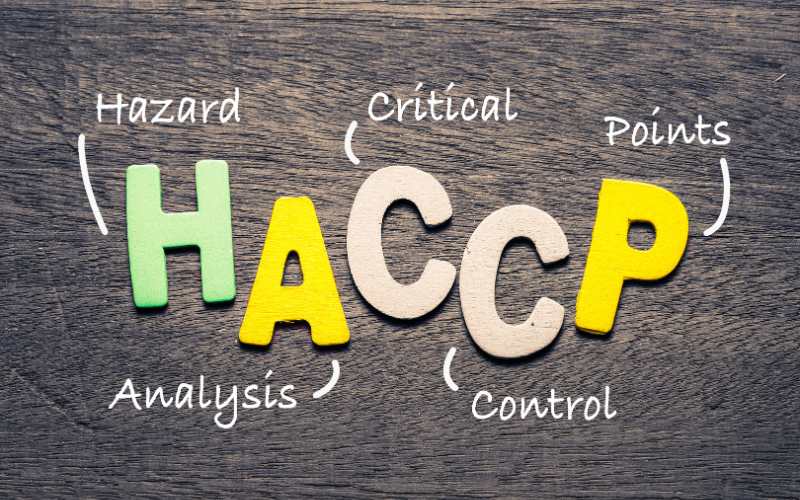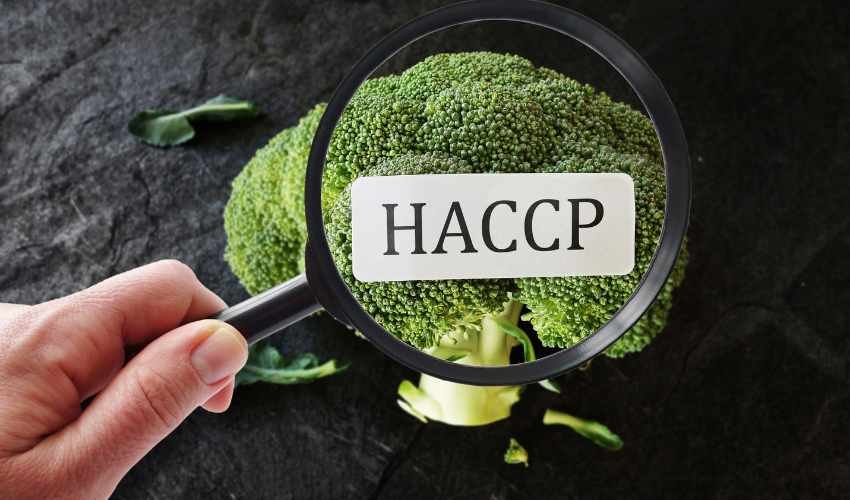
What Is HACCP 7 Principles?
The food market moves quickly these days, so it’s crucial to ensure that the items are safe and high-quality. The Hazard Analysis and Critical Control Points (HACCP) system is vital to accomplishing this objective. HACCP programs aim to systematically detect, evaluate, and control possible risks in food production processes. Let’s examine what is HACCP systems include, why they are essential, and how they support the highest food safety standards.
What is HACCP, and why is it important?
Proactive management approaches, such as HACCP programs, emphasize preventing hazards more than responding to them. NASA created HACCP in the 1960s to guarantee astronauts’ food safety, and it has since spread throughout the world and been embraced by food companies everywhere.
The Hazard Analysis and Critical Control Point (HACCP) system identifies, assesses, and controls potential risks in food manufacturing processes. Ensuring the safety and quality of food products is crucial for customers. This is the significance of hazard critical control point.
Prevents Foodborne Illness
The goal of HACCP is to avoid risks in the first place rather than to address them after they arise. Biological, chemical, and physical contaminants can cause foodborne illnesses. Hazard critical control points help prevent these illnesses by recognizing and reducing hazards at essential stages in the production process.
Ensures Regulatory Compliance
HACCP must be implemented as a part of food firms' food safety management systems by numerous regulatory agencies worldwide. Adherence to hazard critical control point guidelines indicates a dedication to food safety and aids businesses in fulfilling legal obligations.
Enhances Product Quality
HACCP contributes to the enhancement of food items' general quality in addition to reducing foodborne illnesses. Hazard critical control point contributes to the stability and uniformity of product quality by putting control measures in place at crucial junctures in the production process.
Lowers Risks and Liabilities
Product recalls, contamination occurrences and other problems related to food safety can all be lessened with the use of HACCP. Businesses can reduce the risk of expensive recalls, legal ramifications, and reputational harm by managing risks well.
Builds Customer Confidence
Today's consumers are more worried than ever about the safety of their food. Businesses may gain the faith and confidence of consumers by putting HACCP into practice and showcasing their dedication to food safety. This will boost customer satisfaction and loyalty.
Promotes worldwide Trade
In the increasingly globalized food market, hazard critical control point is acknowledged as a global standard for food safety. By guaranteeing that goods fulfill the food safety regulations of many nations and areas, HACCP implementation can promote trade.
HACCP is a proactive and systematic approach to food safety that is crucial for safeguarding the general public's health, guaranteeing regulatory compliance, and upholding food enterprises' integrity and good name. Through identifying and managing hazards at every stage of production, hazard critical control point contributes to the manufacture of food items that are safe, wholesome, and fit for human consumption. Therefore, the importance of HACCP is evident to us.

Critical Components of HACCP Programs
Critical components of HACCP programs include hazard identification, determination of critical control points (CCPs), establishment of monitoring procedures, implementation of corrective actions, verification, record-keeping, and regular review to ensure food safety in the production process.
Hazard Analysis
The process of locating and assessing possible physical, chemical, and biological risks associated with food preparation , processing, production and packaging.
Critical Control Points (CCPs)
The essential establishment of control points (CCPs) allows efficient control to acceptable levels or eliminates dangers.
Monitoring Procedures
Establish procedures in place to monitor CCPs and make sure risks are appropriately managed.
Corrective Actions
Establish procedures for responding appropriately when there are deviations from critical limitations.
Verification
To make sure the HACCP program functions as intended, carry out routine verification tasks.
Record-Keeping:
Keeping thorough records of all HACCP elements, operations, including hazard analyses, monitoring findings, and corrective and preventaive measures.
Benefits of HACCP Programs
- Enhanced Food Safety: By proactively identifying and controlling hazards, HACCP programs help prevent foodborne illnesses and ensure the safety of consumers.
- Regulatory Compliance: Many regulatory agencies such as CFIA, Health Canada, FDA and WHO require food businesses to implement HACCP programs in their food safety management systems.
- Improved Quality: HACCP programs promote consistency and standardization in food production processes, leading to higher-quality products.
- Risk Mitigation: By addressing potential hazards at critical control points, HACCP programs help mitigate risks such as contamination, spoilage, and product recalls.
- Consumer Confidence: Implementing hazard-critical control points demonstrates a commitment to food safety, building consumer trust and confidence.
Common Prerequisites for HACCP Programs
Before implementing HACCP, specific prerequisites must be in place to ensure its effectiveness. These include :
- Good Manufacturing Practices (GMP)
- Sanitation Standard Operating Procedures (SSOP)
- Supplier Approval and Control
- Allergen Control Program
- Traceability and Recall Procedures
- Facility and Equipment Maintenance
- Personnel Training and Hygiene
What are haccp 7 principles?
The HACCP 7 principles are the foundation for developing and implementing an effective food safety management system. Here they are:
- Conduct Hazard Analysis: Identify and assess potential biological, chemical, and physical hazards associated with each step of the food production process.
- Identify Critical Control Points (CCPs): Determine the points where control measures can be applied to prevent, eliminate, or reduce hazards to acceptable levels.
- Establish Critical Limits: Set critical limits for each CCP, which are criteria that must be met to ensure hazards are adequately controlled.
- Monitor CCPs: Develop procedures to monitor CCPs and verify that critical limits are consistently met during production.
- Establish Corrective Actions: Define protocols for taking corrective actions when deviations from critical limits occur, ensuring that hazards are promptly addressed.
- Establish Verification Procedures: Establish procedures for verifying that the HACCP system works as intended, including regular audits, reviews, and testing.
- Maintain Records: Keep detailed records of hazard critical control point activities, including hazard analysis, monitoring results, corrective actions, and verification activities, to demonstrate compliance and facilitate ongoing improvement.
Food companies may efficiently identify, evaluate, and control hazards in their manufacturing processes, eventually guaranteeing the safety and quality of their goods by following these seven principles.

How to conduct a hazard analysis?
Conducting a hazard analysis is critical in developing a Hazard Analysis and Critical Control Points plan. Here's a step-by-step guide on how to conduct a hazard analysis:
- Identify the Scope: Define the parameters of your hazard analysis, such as the food product or procedure you are looking at.
- Assemble a Team: Assemble a multidisciplinary team with specialists in microbiology, operations, engineering, and food safety.
- Describe the Product or Process: Give a thorough explanation of the food product or procedure under analysis, considering the components, preparation, packaging, and intended usage.
- Identify Potential Hazards: Every stage of the food production process should have all possible biological, chemical, and physical dangers identified and listed. Common hazards include microbial infection, allergies, chemical residues, foreign objects, and incorrect handling.
- Evaluate Hazards: Analyze each hazard's likelihood and seriousness. Consider elements, including the type of hazard, how likely it is to cause injury, and the possibility of occurrence.
- Determine Control Measures: Establish controls that can be put in place to stop, get rid of, or lessen the threats that have been identified to a manageable level. Sanitation procedures, supplier approval processes, temperature control, and allergen management are a few examples of control measures.
- Identify Critical Control Points (CCPs): Determine which stages of the manufacturing process require control measures to prevent, eliminate, or reduce hazards to an acceptable level. Usually, CCPs are linked to actions that significantly reduce risk.
- Establish Critical Limits: Establish essential limits for each CCP, which are requirements that must be fulfilled to guarantee that risks are sufficiently managed. Regulatory constraints, industrial standards, or scientific ideas are frequently the foundation for critical limits.
- Document the Hazard Analysis: Record the hazards found, together with a list of related risks, control strategies, critical limits, and CCPs.
- Review and Validate: With the team, go over the hazard analysis to ensure all possible risks have been found and taken care of. Verify the efficacy of control measures by running trials, studies, or tests to validate the hazard analysis.
- Update as Needed: Review and update the hazard analysis regularly to account for new knowledge, evolving risks, and modifications to the food product or process.
These guidelines will help you perform a comprehensive hazard analysis, which is the first step towards creating a successful HACCP plan to guarantee the security and calibre of your food goods.
Conclusion
In the food business, HACCP systems are effective instruments for guaranteeing food safety, quality, and regulatory compliance. By identifying and managing hazards at essential stages in the production process, hazard-critical control points reduce risks, minimize foodborne illness, and foster consumer confidence. HACCP programs enable food enterprises to fulfill the highest standards of quality and integrity and achieve excellence in food safety via correct implementation and adherence to best practices.
HACCP Certification FAQs
What is a food safety and hygiene certificate?
Upon completion of the food safety and hygiene certificate, an individual is granted a certificate in food safety and hygiene. This certificate proves one's ability to avoid foodborne infections and is frequently necessary for jobs in the food sector. After a few years, certificates usually expire and must be renewed through exams or refresher courses. This accreditation improves one's chances of landing a job, guarantees legal compliance, and increases patron trust in restaurants.
What is the HACCP certification cost?
HACCP certification costs vary based on company size, industry, and certification body. Larger organizations may pay $10,000 or more for certification, while small businesses may spend between $1,000 and $2,000 on it. Training, consulting, paperwork, audits, and continuing maintenance are all included in the price.
What is the HACCP audit checklist?
Adherence to the Hazard Analysis and Critical Control Points principles is guaranteed using a HACCP audit checklist. Hazard analysis, CCP identification, critical limits, monitoring protocols, remedial measures, validation, and record-keeping are all included. Food adherence is evaluated using the checklist.
What is HACCP food safety certification?
HACCP food safety certification verifies adherence to its principles. It guarantees that food establishments put robust safety protocols in place, spotting, keeping an eye on, and managing possible risks in manufacturing procedures. Training, audits, paperwork, and compliance with regulations are all part of the certification process. In addition to boosting consumer confidence and demonstrating a commitment to food safety, it can be necessary to comply with industry standards or legal requirements.
How to get HACCP certification online?
Select a trustworthy training provider, sign up for an approved course, finish the training modules, pass the exams, and then get certified to obtain HACCP certification online. To keep your certification valid, be sure you're following the renewal or continuing education requirements. Utilize newly learned information to apply hazard critical control point concepts successfully.
What is haccp training?
HACCP concepts are taught in HACCP training, which is necessary to guarantee food safety. Identification of hazards, crucial control points, monitoring protocols, remedial measures, verification, and record-keeping are all covered. Workshops, seminars, online courses, and in-person instruction are examples of training approaches. Participants gain knowledge on how to recognize and reduce risks to food safety, follow laws, and put into practice efficient HACCP plans in the manufacturing of food. Participants may obtain certification after finishing the course, proving their proficiency with HACCP methods and principles.
What are HACCP certification requirements?
HACCP certification requirements include:
- Completing accredited training.
- Developing a HACCP plan.
- Implementing it in production.
- Conducting internal audits.
- Ensuring compliance with regulations.
- Passing a certification exam.
- Adhering to renewal criteria.
How long does it take to get HACCP certification?
Depending on the training provider and the course, different times are required to receive HACCP certification. The basic concepts and requirements of hazard critical control point are covered in one to three-day introductory training courses. On the other hand, longer certification courses or those with more modules could take longer. Learners can typically advance at their own pace in online courses. For precise information on the length of the HACCP certification program, contacting the certification provider of choice is imperative.
How can Arnika help you with HACCP programs?
Arnika's expertise can significantly support HACCP (Hazard Analysis and Critical Control Points) programs in several ways:
- Consultation Services: Arnika can help companies create and improve their food safety management systems by offering knowledgeable advice and consultancy on applying hazard critical control points.
- Training Programs: Arnika may create and offer specialized training courses on HACCP concepts, prerequisites, and regulatory compliance suited to enterprises' requirements.
- Audits and Assessments: To pinpoint opportunities for development and guarantee compliance with legal and best practices, Arnika may conduct comprehensive audits and assessments of currently in place hazard critical control points systems.
- Documentation Support: Arnika can help companies create and keep up-to-date records of all monitoring and verification operations, standard operating procedures (SOPs), and HACCP plans.
- Ongoing Support: Arnika can offer companies the resources, knowledge, and help they require to guarantee the successful implementation and upkeep of HACCP programs.
By utilizing Arnika's knowledge and resources, businesses can improve their food safety procedures, reduce risks, and comply with hazard critical control point regulations, thereby preserving the calibre and integrity of their goods.
